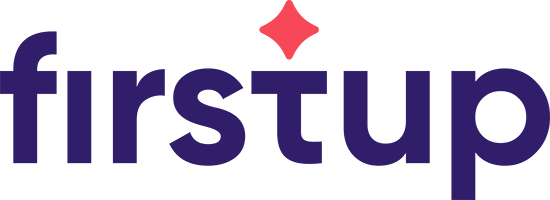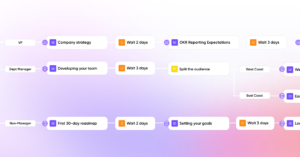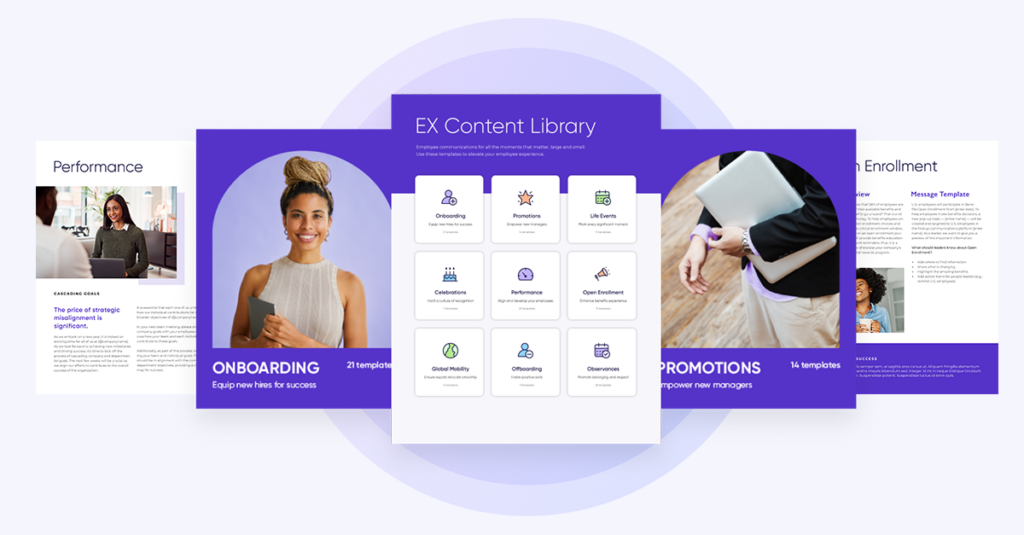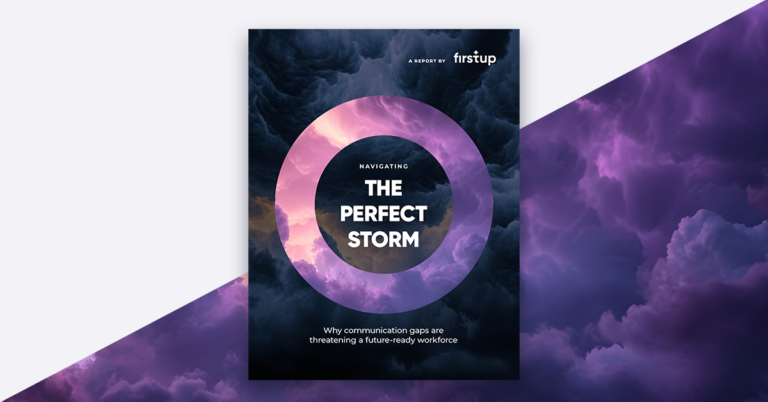The modern workplace presents a new challenge: how to deliver consistently, highly engaging employee experiences across large, distributed workforces? Despite a newfound focus of employee experience (EX) strategy investments, many organizations still struggle to meet employees where they are and drive measurable outcomes in employee engagement and business impact.
The problem? Figuring out how to scale communication in a way that’s personalized, timely, and aligned with the employee experience to grow engagement.
This blog post explains why most EX strategies fail, reveals the hidden costs of a bad communication strategy, and shares real-world examples of companies solving these challenges with FirstUp.
What is an employee experience strategy?
An employee experience strategy is a comprehensive plan that aligns organizational practices, tools, and communication with employees’ needs and expectations. It integrates the efforts of HR, IT, and internal communications to ensure each employee is supported, informed, and empowered throughout their journey.
Remember that the employee experience is made up of all the interactions an employee has with your organization—from recruitment and onboarding to daily operations and promotions to eventual exit. These interactions include cultural, digital, and physical touchpoints, each significantly influencing an employee’s motivation, performance, and connection to both their work and your organization’s goals.
Increasingly, organizations are adopting employee experience strategies that treat employees as internal customers, recognizing that their experiences with internal systems, leadership communication, and company culture directly impact business success.
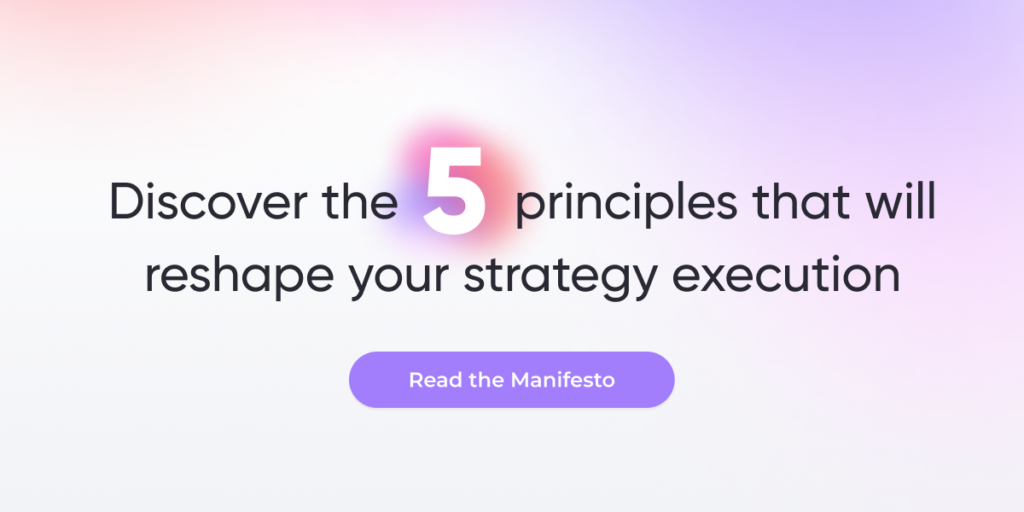
How does the employee journey impact the employee experience?
Each stage of the employee journey (recruitment, onboarding, engagement, performance, development, retention, exit) impacts how employees experience their roles and perceive your organization.
Understanding the employee journey is key to creating an effective employee experience strategy, as it helps you identify critical moments that influence employee engagement.
Not to be confused with the employee experience, employee engagement refers to employee satisfaction, passion, and commitment to their job. Engaged employees understand their purpose within your organization, where they fit in, and how they can help achieve business impact.
What is the goal of an employee experience strategy?
Your employee experience strategy should foster highly engaged employees.
To support employees, you have to do more than send out one-off, inspirational messages. Instead, organizations must consistently deliver timely, contextually relevant information, personalized to each employee’s role, location, behavior, and stage in the employee journey. Without this ability to scale personalized communication, your employee experience strategy will struggle to engage employees and ultimately drive business impact.
Why most communication platforms don’t support a scalable EX strategy

Most organizations don’t have the tools to drive strong employee engagement at scale. This usually stems from a lack of personalization, limited contextual awareness, and technology that focuses on systems instead of people.
Messages lack personalization
Most communication platforms treat employees as one homogenous group, pushing out the same, generic message to all employees, no matter their role, location, behavior, or journey stage.
Thanks to over-generalized communication strategies, 21% of employees say the communications they receive are irrelevant to their roles or responsibilities. And when communication is overly generalized, it becomes noise. Employees tune out, ignore updates, or miss critical information entirely, ultimately hurting engagement.
Communication delivered in the wrong channels
In many cases, organizations don’t just send the wrong message to the wrong people—they send it in the wrong place, too.
Consider: 69% of companies still rely on email as their primary communication channel. But 54% of deskless workers report having limited or no access to email, while 51% would prefer to receive updates via mobile-based channels, such as text messages or push notifications.
When organizations fail to meet employees where they are, not only do most employees miss critical updates and fail to understand the relevance of corporate initiatives, but they end up feeling disengaged and out of touch.
Poor alignment with the employee journey
With generic messages and wrong-channel delivery, traditional platforms fail to align communication strategies with the full employee experience.
The result? Employees end up receiving the wrong message at the wrong moment—or miss it altogether. Without alignment to the employee journey, communication becomes disruptive noise instead of a useful guide.
Fragmented communication channels
From intranets and shared Google Drives to emails and Slack channels, many communication platforms have become digital dumping grounds for content. This disorganization creates unnecessary friction and makes it difficult for employees to find what matters.
In fact, 25% of employees say they don’t know where to look when they need critical updates, and 22% say there are too many places to find company information.
Technology prioritizes systems over people
Most legacy communication platforms were built to support IT infrastructure or content management—not employee engagement. In other words, they focus on message delivery and lack the intelligence to craft timely, personalized, contextually relevant messages that align with each employee’s journey.
As a result, critical messages miss the mark, leaving organizations unable to engage, align, and activate their workforce when it matters most.
Metrics focus on activity, not impact
Many “engagement” tools track open rates, click-throughs, and read receipts. These metrics may create the illusion of connectivity, but they provide little insight into whether communication efforts are actually driving understanding, alignment, and behavior change. In other words, most platforms track interaction but not impact.
Real engagement is measured by outcomes, i.e., Did the employee receive the right information? Has there been a change in performance or participation? Did the employee take the desired action?
No way to scale personalized communication
Perhaps the most critical limitation of most communication platforms is scalability.
Consider the math: If your organization supports 10,000 employees working across 100 initiatives, each requiring 10 unique touchpoints—then you have to orchestrate 10 million communication moments. Manually planning and managing this level of employment is simply not possible.
The complexities intensify when you consider 92% of organizations include mixed environments of both desk-based and deskless workers, adding layers of varying accessibility, location, timing, etc.
Legacy communication platforms were simply not designed to support this level of segmentation and are fundamentally unable to support thousands of employees with personalized journey automation.
Belonging drives engagement
The cost of a bad EX strategy: fragmented communications and failed initiatives
A poor employee experience strategy does more than hurt engagement—it creates real, measurable business risk. When communication fails, so too do productivity and strategy, giving your competitors opportunities to get ahead.
Employees struggle to stay productive
When employees don’t receive timely and relevant information, productivity suffers. Instead of focusing on the work that matters, they spend excessive time searching for what they need.
In fact, employees waste 9.3 hours every week (nearly a full day) searching for information they need to perform effectively. And this wasted time has consequences: 82% of employees report missing critical information needed to do their jobs effectively, leading to frustration, disengagement, and eventually, departure.
The fix is clear: 61% believe timely and relevant updates would directly improve their performance and productivity.
Disengagement becomes widespread
When your communication delivers irrelevant or poorly timed messages, it doesn’t just stall productivity—it drives disengagement and sows dissatisfaction:
- 52% of employees rate their organization as only “somewhat effective” at communicating essential updates.
- 32% believe their company is significantly less effective at reaching deskless workers compared to desk-based peers.
- 20% say communication in their organization is ineffective or entirely lacking.
Disengaged, dissatisfied employees are less productive, less innovative, and more likely to quit. Worldwide, Gallup says disengaged employees cost companies $8.8 trillion.
Strategic initiatives lose momentum
No matter how robust a new strategic initiative, if your organization doesn’t have the communication infrastructure to support it, there’s a high risk of failure.
In fact, 70% of transformational initiatives fail to achieve their intended outcomes due to poor communication and execution. In many cases, strategies developed by executives never reach the employees responsible for implementation. This phenomenon—“strategy evaporation”—happens when there’s no visibility into who gets what message, when, or what action follows.
Without a modern employee experience strategy that can support thousands of personalized journeys at scale, many visionary strategic plans will lose momentum before they ever reach the frontlines.
Competitors pull ahead
A weak employee experience strategy doesn’t just create inefficiencies within your organization; it also creates a competitive disadvantage.
While your employees are searching for information across disparate touchpoints, your competitors are accelerating execution, adapting in real time, and bringing strategies to life. Today, speed matters more than ever—and that speed starts a modern employee experience strategy that consistently delivers right-time, right-channel communications to inform, empower, and engage every employee.
Improving EX strategy with workforce orchestration
Workforce orchestration takes the same precision, personalization, and real-time responsiveness you’re used to applying to customer experience—and brings it to your organization’s internal communications. Specifically, it ensures the right people receive the right information at the right time, through the right channels, with the right context.
But workforce orchestration isn’t just a better way to send messages. It’s a fundamentally different approach to aligning, engaging, and activating your workforce—and it’s a strategic necessity for organizations that want to scale and strengthen engagement to accelerate initiative execution and drive business impact.
Here’s how workforce orchestration supports a more scalable, impactful employee experience strategy:
Scale personalization with employee data
To scale engagement, you must first scale personalization. Workforce orchestration makes this possible with an employee data foundation—a purpose-built platform that integrates with your HRIS to understand who each employee is, what they need to know, and how they prefer to receive information. This way, organizations can:
- Segment employees by role, location, behavior, and journey stage
- Tailor messaging to align with each employees’ needs and context
- Delivery messages in real time through the most relevant, accessible channels
In turn, by delivering personalized communications at scale, organizations help increase employee engagement by fostering strong employee connections; 30% say effective communication makes them feel more connected to their colleagues.
Enable strategic adjustments with real-time controls
Driving engagement at scale requires the ability to adjust quickly without disruption. Workforce orchestration empowers organizations with centralized control centers that let leadership pause, resume, or modify active journeys as needed—without disrupting the employee experience or breaking continuity.
This level of agility is especially critical when strategies change, timelines shift, or new priorities emerge. In fact, McKinsey reports that organizations that are primed for agility can improve efficiency, employee engagement, operational performance, and even customer satisfaction by 30%.
Adapt communication in real time with AI
Scalable engagement requires intelligent systems that respond to how employees behave in real time. With AI-powered orchestration, organizations can maintain constant awareness of each employee’s journey state—and then dynamically adjust content delivery accordingly:
- Timing messages for when they’re most likely to be seen
- Choosing the best channel based on individual engagement
- Shaping message flow in response to employee behavior and engagement
This ability to adjust flow dynamically transforms communication from static, generic broadcasting to responsive, personalized experiences that meet employees where they are.
Track accountability with analytics
An effective employee experience strategy isn’t just about information delivery. It’s also about paying attention to what employees do with that information and the ultimate impact on strategic outcomes.
This kind of execution intelligence goes beyond vanity metrics like click-throughs and read receipts. Instead, it uses analytics that track engagement at each journey step to measure:
- Whether employees received and engaged with the message
- If they understood the content
- How the information led to a behavior or performance change
By closing the feedback loop between strategy and execution, workforce orchestration introduces a level of accountability and measurability that’s usually reserved for consumer experiences and journey-tracking.
The business impact of a strong employee experience strategy

An employee-centric communication approach helps your organization drive higher employee engagement. Bigger picture, that translates to greater organizational performance, from productivity to profit.
Greater productivity
When employees get the right information at the right time in the right channel, they can spend less time searching for information and more time doing. In this way, personalized communications keeps teams focused on what matters most, driving measurable productivity gains.
Higher engagement
When communication is relevant, timely, and personalized, employees feel more connected to their work, their colleagues, and your company’s mission:
- 33% say effective communication improves engagement
- 27% say it boosts motivation
- 29% say it increases participation in company initiatives
Better talent attraction and retention
A positive employee experience helps attract top talent. At the same time, it engages employees and encourages them to stay.
With only about half of Americans highly satisfied with their job, the era of quiet quitting continues. By investing in strong employee experiences that drive engagement, organizations can foster greater loyalty, reduce churn, and entice more high-performing talent to join your team.
Boosted profitability
Employee experience directly impacts overall business success.
In fact, organizations that modernize their communication infrastructure report higher engagement and a 23% increase in profitability. Conversely, disengaged employees can cost S&P 500 companies about $282 million per year.
Better customer experiences
There’s a clear link between positive employee experiences and customer experiences. When employees are happier and more engaged, they’re not only more productive, but they deliver better service, solve problems faster, and build stronger customer relationships.
In fact, companies with highly engaged workforces outperform their competitors.
Stronger competitive advantage
Organizations with a well-orchestrated employee experience strategy move from strategy to execution in days—not quarters. Faster alignment, better measurement, and continuous optimization create a strategic edge that competitors without a modern EX strategy can’t match.
Why now: it’s time to modernize your employee experience strategy
There’s a clear divide across organizations. One one side: companies bogged down by outdated communication platforms and disengaged employees. On the other: forward-thinking leaders who recognize that scaling employment engagement and creating a positive employee experience are foundational for ongoing business success.
Why now? Modern challenges require modern communication strategies—and an unprecedented urgency for organizations to rethink how they engage workforces:
- AI is moving faster than your workforce
By 2026, 80% of enterprises will have adopted AI technologies, reshaping the way work is done across every industry. Nearly 40% of core worker skills are expected to change.
To keep up, organizations must quickly upskill and redeploy talent. But that can’t happen if employees—especially frontline and deskless workers—can’t access the information and training they need. Without a strategy that can deliver role-specific updates at scale, organizations will fall behind in months, not years.
- Old technology can’t connect modern teams
Work is no longer confined to the office. It’s now a complex environment of both physical and digital touchpoints. But when company information is scattered across intranets, Slack threads, and emails, productivity takes a hit.
At the end of the day, this fragmentation costs organizations 20–30% of productivity potential.
- Modern workforces have new priorities
Modern workforces want more than just a paycheck—they demand purpose and growth. But when 24% say poor communication makes them feel disconnected from company culture, it’s clear that old strategies aren’t meeting new expectations.
This drives disengagement, burnout, and attrition. And each departure costs 1.5–2X an employee’s annual salary.
- Strategy cycles move fast
Strategy execution cycles are shrinking. What used to take years now happens in just quarters. Organizations that continue to rely on outdated strategies will fall behind more agile, forward-thinking competitors.
- Poor communication is expensive
Knowledge workers can cost upwards of $125,000 per year. When 22% of that investment is lost to poor communication and inefficient information flow, it means a 5,000-person organization forfeits over $137 million each year.
What if your organization has 10,000 employees? Without a modern employee experience strategy, you’re not just compromising communication—you’re wasting millions in lost productivity and opportunity.
EX strategy in the real world: How Firstup helps organizations overcome communication challenges to scale employee engagement
When communication breaks down, strategy stalls. Here are three real-world examples of how Firstup helped companies overcome communication gaps and drive employment engagement with personalized, timely, scalable communication.



